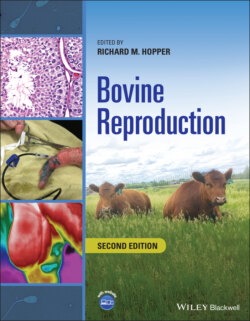Читать книгу Bovine Reproduction - Группа авторов - Страница 362
Plane of Nutrition
ОглавлениеBody energy reserves and metabolic state are relevant modifiers of puberty onset and fertility. Heifers in a peripubertal state may be induced to ovulate by abruptly increasing the plane of nutrition [39, 40]. A study by Chelikani et al. [41] involving Holstein heifers illustrates this point. Heifers were fed to gain 1.1, 0.8, or 0.5 kg/day from 100 kg liveweight. Age at puberty for the three groups was 9, 11, and 16 months, respectively. Precocious puberty (<300 days of age) can be induced in beef heifers by early weaning and feeding a high‐concentrate diet [42]. The mechanism by which early weaning and feeding a high‐concentrate diet results in precocious puberty in heifers is associated with advancement of the reduction of estradiol negative feedback on secretion of LH. The mechanisms linking nutrition and metabolism to puberty are not clearly understood, but it appears several neuropeptides operating in a reciprocal manner (orexigenic and anorexigenic) are involved.
Kisspeptin is a primary candidate for modulating the effects of nutrition on reproduction. Kisspeptin acts in the role as a final common pathway to integrate stimulatory and inhibitory inputs to influence GnRH synthesis and release. Much of the work with this hormone has been in a rodent model, but one may speculate that the same mechanisms are operational in cattle. Kisspeptin signaling in the hypothalamus has been suggested as the primary positive regulator of the GnRH pulse generator [43]. In the mid‐1990s, the adipose hormone leptin was shown to be an essential signal for transmitting metabolic information to the centers governing puberty and reproduction and kisspeptins have emerged as conduits for the metabolic regulation of reproduction and putative effectors of leptin actions on GnRH neurons [44]. Leptin is produced by adipocytes and regulated by long‐term and recent nutritional status [45]. Circulating leptin concentrations increase as puberty approaches but do not change appreciably in response to dietary change when percentage of total carcass body fat is above a minimum threshold, indicating that a certain minimum body condition is required for puberty [46]. Ghrelin and other metabolic effector hormones known to modulate the hypothalamic–pituitary–gonadal axis, such as neuropeptide Y, melanocortins, and melanocyte‐concentrating hormone, are additional putative regulators of the hypothalamic/kisspeptin system [44].
